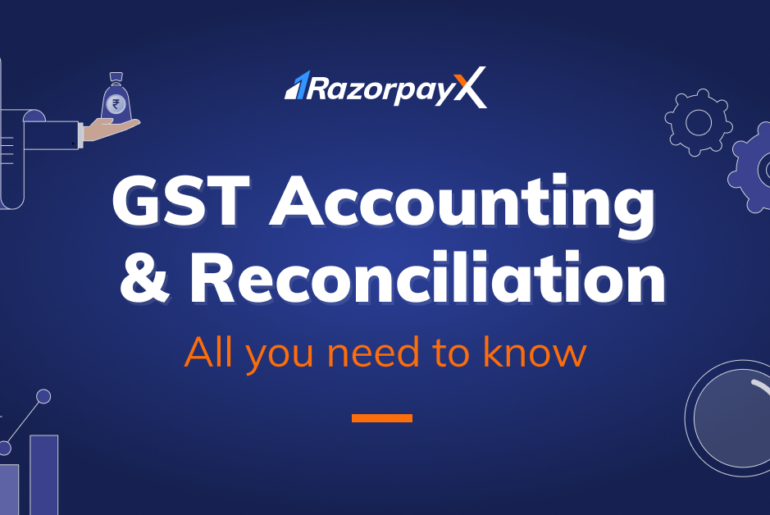Are you finding GST accounting and reconciliation difficult?
GST accounting is when you make entries into your books related to the goods and services provided and received.
Consider this example.
If a juice shop has purchased apples for Rs.100 and sold apple juice for Rs.150, the shop owner (business owner) would have paid GST to the apple vendor and collected GST from the apple juice customer. The process of reconciling apple purchase and apple juice sales (GST amounts) is called GST reconciliation
Multiple tax levies have been replaced under the GST regime by a single GST tax, resulting in major changes in the accounts that business owners should maintain.
Previously, individuals had to maintain individual accounts for CST, excise, VAT, and other service taxes with separate output, input, and credit entries for each of them. And now, the new tax regime implies an entirely new list of accounts consisting of the GST components.
This new GST regime brings along the vital concepts of GST accounting and reconciliation which you, as a business owner, must be aware of.
Let’s dive deeper into all things GST accounting and reconciliation.
Table of Contents
How to pass accounting entries under GST?
While accounting of GST is simple, you should understand and pass accounting entries regularly. It is imperative to ensure minimum or zero mismatches between the GST returns and books of accounts.
Here’s an example to understand accounting entries under GST:
Mr. X buys products worth Rs. 10,000 at a local market. Then, he sells the products for Rs. 30,000 at the same place. Additionally, he paid a consultation charge of Rs. 500. He also buys furniture worth Rs. 10,000, considering his firm’s expansion. Assume an SGST rate of 10% and a CGST rate of 10%.
The entries will look like this:
| Sl. No. | Particulars | Debit (Rs.) | Credit (Rs.) |
| 1 | Purchase account | 10,000 | |
| CGST Input account | 1,000 | ||
| SGST Input account | 1,000 | ||
| To creditors account | 12,000 | ||
| 2 | Debtors account | 36,000 | |
| To Sales account | 30,000 | ||
| To Output CGST account | 3,000 | ||
| To Output SGST account | 3,000 | ||
| 3 | Consultation fee account | 500 | |
| CGST Input account | 50 | ||
| Input SGST account | 50 | ||
| To Bank account | 600 | ||
| 4 | Furniture account | 10,000 | |
| CGST Input account | 1,000 | ||
| SGST Input account | 1,000 | ||
| To furniture account | 12,000 |
By GST accounting entries,
- Total Input SGST = 1,000 + 50 + 1,000 = Rs. 2,050
- Total Output SGST = Rs. 3,000
- Total Input CGST = 1,000 + 50 + 1,000 = Rs. 2,050
- Total output CGST = Rs. 3,000
Hence,
- Net SGST to be paid = 3,000 – 2,050 = Rs. 950
- Net CGST to be paid = 3,000 – 2,050 = Rs. 950
Accounting under the GST regime
Under GST, all indirect taxes like VAT, service tax and excise are subsumed into a single account. For every GST Identification Number (GSTIN), one needs to maintain the following accounts besides the accounts like sales, stock, purchases:
- Electronic Cash Ledger – this must be maintained on the Government GST portal in order to deposit GST in cash and make payments from there
- Input IGST account
- Output IGST account
- Input cess account
- Output cess account
- Input CGST account
- Output CGST account
- Input SGST account
- Output SGST account
What is GST reconciliation?
Typically, reconciliation refers to the matching of two data sets to evaluate differences. Also, reconciliation helps keep a tab on manual errors. GST reconciliation involves matching data of purchase and sales between different returns and purchase and sales registers. Under GST, reconciliation helps taxpayers know if taxes are excess/short paid or not paid at all.
These are some of the major reasons why GST reconciliation is vital:
- To validate data through the reconciliation of different GST returns
- To keep a tab on the duplicity of data
- To issue file amendments or CDNs if there is a mismatch because of duplicity of data or human error
- To claim accurate Input Tax Credit (ITC) for invoices raised in the previous financial year
Listed below are the different types of GST reconciliation:
- Reconciliation between GSTR-1 and GSTR-3B to determine discrepancies in sales details
- Reconciliation between provisional ITC and actual ITC which is claimable under GSTR-2B
- Reconciliation between GSTR 2A or GSTR-2B and GSTR- 3B to match Input Tax Credit
How to do GST reconciliation?
Now that you are aware of the GST reconciliation meaning let’s move on to know how it’s done. To start with, reconciliation should be done for every GSTIN. Then it should be considered at a PAN level. GST reconciliation should be carried out across months for the whole financial year. Also, the amendments made to GST returns of the last financial year in the present FY should be considered as well.
The most vital component of GST returns is ITC (Input tax credit). This is because it holds more relevance in comparison to other components of GST returns.
The stage in which the checking of the genuineness of claims was done in the previous tax regime is different than that of the present GST regime. A taxpayer can now confirm the genuineness at a stage of filing GST returns (vis-a-vis with GSTR-2A or GSTR-2B and taking action). Previously, tax authorities conducted this check at the time of processing the returns.
Therefore, vendor-wise reconciliation should be carried out regularly. If not done, taxpayers should do so prior to filing GST returns in September of the financial year following the relevant FY. That helps declare and identify unclaimed ITC within the deadline.
- Match the table of exports at 6A of GSTR-1 vis-a-vis shipping bill details submitted on ICEGATE portal
- Compare annual Income Tax Return with annual GST return
- Reverse the ineligible ITC if it’s not identified and done earlier or claim ITC of a relevant financial year if not claimed previously.
- Match the table of exports at 6A of GSTR-1 vis-a-vis corresponding declaration in GSTR-3B
Declaration of turnover from business (at PAN level)
- Compare ITC in GSTR-3B vis-a-vis GSTR 2A for the whole year
- Compare purchase register vis-a-vis GSTR-2A for the whole financial year
- Compare GSTR-1 vis-a-vis GSTR-3B
Major challenges with GST reconciliation
Listed below are the major issues with reconciliation under GST are:
- The purchaser’s invoice date does not match with that of the seller. This occurs because of the difference in the recording date of the invoices at both places. A majority of the purchasers stay at fault regarding this as they do not enter the same date as that in the sales invoice.
- Recording of invoices by the supplier and purchaser in different return periods.
- The invoice number that a purchaser records do not match with the invoice that the seller receives in GSTR-2B. Both of them follow a separate convention.
- Suppose a purchaser works in multiple states, and the seller raises an invoice with some other GSTIN/HQ GSTIN rather than the actual purchaser GSTIN. In such a case, it may not entirely reflect at a GSTIN level.
- Instances of multiple invoices between a supplier and purchaser where every invoice value is the same at different dates and one of the parties has recorded invoices greater than the other. This takes place in the case of regular fixed supply business.
- Invoice value from purchaser and supplier differs by a minor value as both parties have separate conventions of rounding off.
- When only the invoice value matches between two parties and the date and invoice number do not match
GST accounting and reconciliation for small businesses
Small businesses are the backbone of the Indian economy. Initially, monitoring transactions aren’t that tasking for these businesses. But as they grow, you will see numerous invoices in a month. At that time, even a single-digit percentile proves to be a considerable volume. Hence, small business owners should reconcile the returns data regularly under GST.
It is essential to store all accounts and records at one location where every business account and record is maintained. Also, small business owners should ensure efficient accounting and record keeping if records are maintained online. You should also ensure that every record can be shown at any time.
How RazorpayX helps small businesses
RazorpayX Vendor Payments is built for startups. It automates everything annoying about GST and vendor invoice payments. It automatically captures:
- GSTINs of vendors
- GSTINs from the invoices and matches them with vendors
- Details of CGST, IGST and SGST details from invoices and export them to match the ITC reconciliation
- Automatic accounting of GST ledgers for all the supplier payments in Zoho and Tally
Read more:





